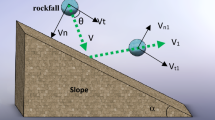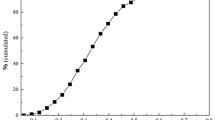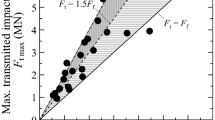Abstract
Rockfall is a significant geological hazard in the mountain areas of Western China, which causes damage to residential and infrastructures. Velocity analysis of rock impacts on the cushion layers is a powerful method to predict the effectiveness of a protective cushion. Thus, this study investigates the velocity, angle, and angular velocity of rockfall after collision, considering the cushion layer's statistical nature, different slope angles, and collision positions. A stochastic collision model of the rockfall–cushion layer is established in this study to understand the mechanism of the collision process. Impulse and impulse moment theorems form the basis for the analytical solution of the velocity after the collision. The results show that the radius ratio of rockfall and cushion particle and slope angle are essential for rockfall–cushion layer collision. The probability distributions of rebound velocity, rebound angle, and rebound angular velocity follow the Gaussian distribution based on probability theory. When the radius ratio of rockfall and cushion particle is larger than the critical radius ratio Rcr, the radius ratio of rockfall and cushion particle no longer affects the collision process. The mean and standard deviation of rebound velocity, rebound angle, and rebound angular velocity after collision are fitted as the radius ratio of rockfall and cushion particle and slope angle functions, respectively. Therefore, it cannot ignore the influence of the radius ratio of rockfall and cushion particle, slope angle, and microstructure of slope surfaces in designing protective cushions.







Similar content being viewed by others
Data availability
The data used to support the findings of this study are available from the corresponding author upon request.
References
Agliardi F, Crosta GB, Frattini P (2009) Integrating rockfall risk assessment and countermeasure design by 3D modeling techniques. Nat Hazards Earth Syst Sci 9(4):1059–1073
Asteriou P, Tsiambaos G (2015) Empirical model for predicting rockfall trajectory direction. Rock Mech Rock Eng 49(3):1–15
Chau KT, Wong RHC, Wu JJ (2002) Coefficient of restitution and rotational motions of rockfall impacts. Int J Rock Mech Mining Sci 39(1):69–77
Chen TJ, Zhang GC, Zhang C, Gao X, Zheng Y (2019) Normal impact test of an sph-erical rockfall. Geotech Geol Eng 37(6):4889–4899
Collins B, Stock G (2016) Rockfall triggering by cyclic thermal stressing of exfoliation fractures. Nat Geosci 9(5):395–400
Cui SH, Pei XJ, Huang RQ (2017) Rolling motion behavior of rockfall on a gentle slope: an experimental approach. J Mountain Sci 14(8):1550–1562
Dorren LKA, Maier B, Putters US et al (2004) Combining field and modeling techniques to assess rockfall dynamics on a protection forest hillslope in the European alps. Geomorphology 57(3/4):151–167
Di Luzio E, Mazzanti P, Brunetti A et al (2020) Assessment of tectonic-controlled rockfall processes threatening the ancient Appia route at the Aurunci Mountain pass (central Italy). Nat Hazards 102:909–937
Duan SZ, Sun JL (2020) Exploration of probability distribution of velocities and trajectory of rolling stone based on stochastic rolling stone collision. Geotech Geol Eng 38:3931–3940
Duan SZ, Jin W, Sun JL, Wang WD (2022) Trajectory analysis of the rockfall based on the effect of rotating angular velocity. Geotech Geol Eng 40:121–131
Froude MJ, Petley DN (2018) Global fatal landslide occurrence from 2004 to 2016. Nat Hazards Earth Syst Sci 18(8):2161–2181
Ferrari F, Giacomini A, Thoeni K (2016) Qualitative rockfall hazard assessment: a comprehensive review of current practices. Rock Mech Rock Eng 49(7):2865–2922
Ge Y, He XR, Yuan XQ et al (2021) Analysis of rockfall hazards stopping position and energy dissipation based on orthogonal experiment. E3S Web Conf 261:01004
He K, Li Y, Ma G et al (2021) Failure mode analysis of postseismic rockfall in shattered mountains exemplified by detailed investigation and numerical modeling. Landslides 18:425–446
Huang RQ, Liu WH, Zhou JP et al (2010) Experimental field study of movement characteristics of rock blocks falling down a slope. J Earth Sci 21(3):330–339
Hu J, Li SC, Shi SS, Hu J, Li SC, Shi SS, Zhang Q, Liu HL (2018) He P (2018) Experimental study on parameters affecting the runout range of rockfall. Adv Civil Eng PT.2:1–9
Ji ZM, Chen ZJ, Niu QH et al (2019) Laboratory study on the influencing factors and their control for the coefficient of restitution during rockfall impacts. Landslides 16:1939–1963
Kawahara S, Muro T (2006) Effects of dry density and thickness of sandy soil on impact response due to rockfall. J Terra-Mech 43(3):329–340
Lv Q, Zhou CF, Yu Y et al (2017) Expe-rimental study on fragmentation effects of rockfall impact upon the slope. Chin J Rock Mech Eng 36(s1):3359–3366. https://doi.org/10.13722/j.cnki.jrme.2016.0385
Laimer HJ (2020) Determination of rockfall design blocks in upper triassic limes-tones and dolomites (dachstein formation, northern calcareous alps). Bull Eng Geol Environ 79(3):1581–1590
Lambert S, Kister B (2018) Efficiency assessment of existing rockfall protection embankments based on an impact strength criterion. Eng Geol 243:1–9
Laborious V, Descoeudres F, Montain S (1996) Experimental study of rock sheds impacted by rock blocks. Struct Eng Int 6(3):171–176
Mineo S (2020) Comparing rockfall hazard and risk assessment procedures along roads for different planning purposes. J Mt Sci 17(3):653–669
Ma K, Liu G, Xu N et al (2021) Motion characteristics of rockfall by combining field experiments and 3D discontinuous deformation analysis. Int J Rock Mech Min Sci 138(4):104591
Mougin JP, Perrotin P, Mommessin M et al (2005) Rockfall impact on reinforced concrete slab: an experimental approach. Int J Impact Eng-Ing 31(2):169–183
Nagendran SK, Ismail MAM (2019) Analysis of rockfall hazards based on the effect of rock size and shape. Int J Civ Eng 17(12):1919–1929
Ng CWW, Edward Choi C, Yuchen S, Kwan J, Lam C (2016) Large-scale successive boulder impacts on a rigid barrier shielded by gabions. Can Geotech J 53(10):1688–1699
Ng CWW, Su Y, Choi CE, Song D, Lam C, Kwan JSH, Chen R, Liu H (2018) Comparison of cushioning mechanisms between cellular glass and gabions subjected to successive boulder impacts. J Geotech Geoenviron 144(9):04018058
Omran A, Fahmida K, Schröder D et al (2021) GIS-based rockfall hazard zones modeling along the coastal Gulf of Aqaba Region. Egypt Earth Sci Inform 14:691–709
Plantard G, Papini M (2005) Mechanical and electrical behaviors of polymer particles. Experimental study of the contact area between two particles. Experimental validation of a numerical model. Granul Matter 7(1):1–12
Pei XJ, Luo J, Huang RQ (2019) Failure mechanisms of wind-induced postseismic rockfall hazard. Bull Eng Geol Environ 78:5707–5725
Nagendran SK, Ismail MA (2019) Analysis of rockfall hazards based on the effect of rock size and shape. Int J Civ Eng 17:1919–1929
Sun SQ, Li SC, Li LP, Shi SS, Wang J, Hu J, Hu C (2019) Slope stability analysis and protection measures in bridge and tunnel engineering: a practical case study from Southwestern China. Bullet Eng Geol Environ 78(5):3305–3321
Su Y, Choi C (2020) Effects of rock shape on the cushioning mechanics of rock-filled gabions. Acta Geotech 16(4):1043–1052
Singh AK, Kundu J, Sarkar K et al (2021) Impact of rock block characteristics on rockfall hazard and its implications for rockfall protection strategies along Himalayan highways: a case study. Bull Eng Geol Environ 80(7):5347–5368
Volkwein A, Schellenberg K, Labiouse V, Ag-liardi F, Berger F, Bourrier F, Dorren L, Gerber W, Jaboyedof M (2011) Rockfall characterization and structural protection: a review. Nat Hazards Earth Syst Sci 11(9):2617–2651
Wang Y, Jiang W, Cheng S et al (2018) Effects of the impact angle on the coefficient of restitution based on a medium-scale laboratory test. Natl Hazards Earth Syst Sci Discuss 18:1–22
Wang X, Frattini P, Stead D et al (2020) Dynamic rockfall risk analysis. Eng Geol 272:105622
Xie L, Zheng XJ, Zhou YH (2003) A theoretical study of the distribution of the initial velocity of saltating sand particles by collision. Key Eng Mater 243–244:613–618
Yoon J, Ban H, Hwang Y et al (2020) Mitigation method of rockfall hazard on rock slope using large-scale field tests and numerical simulations. Adv Civ Eng 2020:1–6
Yan P, Zhang J, Kong X et al (2020) Numerical simulation of rockfall trajectory considering arbitrary shapes of falling rocks and terrain. Comput Geotech 122:103511
Yang X, Zhang G, Yu Y et al (2021) Factors influencing the coefficient of restitution in rockfall impacts. Nat Hazard Rev 22(3):1527–6996
Yilmaz I, Yildirim M, Keskin I (2008) A method for mapping the spatial distribution of RockFall computer program analyses results using ArcGIS software. Bull Eng Geol Environ 67(4):547–554
Zhu C, He M, Yin Q et al (2021) Numerical simulation of rockfalls colliding with a gravel cushion with varying thicknesses and particle sizes. Geomech Geophys Geo-Energy Geo-Resour 7(1):1–15
Zhou Y, Shi S, Tang H, Wang L (2020) Assessment of rockfall hazards of Mozi-yan in Hechuan District, Chongqing, China. Geotech Geol Eng 38:5805–5817
Zhu C, Wang DS, Xia X et al (2018) The effects of gravel cushion particle size and thickness on the coefficient of restitution in rockfall impacts. Nat Hazards Earth Syst Sci 18(6):1811–1823
Zhang SL, Yang XG, Zhou JW (2018) A theoretical model for estimating maxi-mum impact force from a rockfall based on contact theory. J Mountain Sci 15(002):430–443
Acknowledgements
This study was supported by the National Natural Science Foundation of China (Grant No. 11702124), Doctor Funding of Lanzhou University of Technology (Grant No. 04-061407). The authors would like to express their sincere appreciation to these supports.
Author information
Authors and Affiliations
Contributions
SD: Conceptualization, Methodology, Funding acquisition, Writing-original draft. X: Software, Data curation, Validation, Formal analysis, Writing review and editing. BX: Investigation, Data curation, Visualization. XW: Writing review and editing, Supervision.
Corresponding author
Ethics declarations
Conflict of interest
The authors declare that they have no known competing financial interests or personal relationships that could have appeared to influence the work reported in this paper.
Additional information
Publisher's Note
Springer Nature remains neutral with regard to jurisdictional claims in published maps and institutional affiliations.
Rights and permissions
About this article
Cite this article
Duan, S., Yang, X., Xu, B. et al. The Influence of Gravel Particle Diameter and Slope Angle on a Rockfall–Cushion Layer Collision. Geotech Geol Eng 40, 5127–5138 (2022). https://doi.org/10.1007/s10706-022-02207-5
Received:
Accepted:
Published:
Issue Date:
DOI: https://doi.org/10.1007/s10706-022-02207-5




